Why was this city centre roundabout replaced?
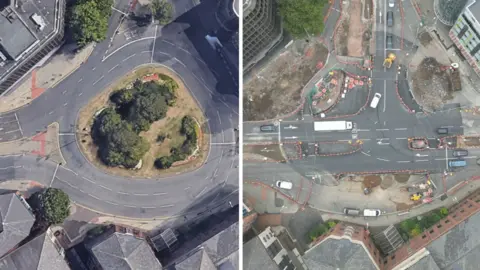 Google/BBC
Google/BBCIt was once described as one of the ugliest roads in Europe following its development in the 1960s.
Maid Marian Way, which serves as one of the main routes in Nottingham city centre, is now the subject of more debate after a roundabout on the road was replaced with a T-junction.
Nottingham City Council say the multi-million pound project is necessary because the roundabout had become "outdated" and "polluted".
But the scheme has bemused some and left others frustrated by the disruption caused by the ongoing roadworks.
Why is the council replacing the roundabout?
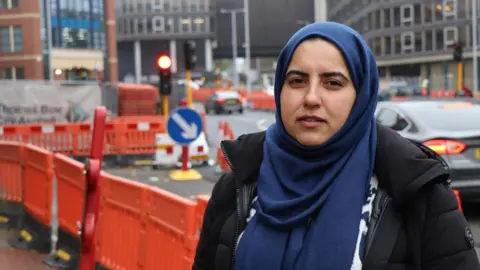
The council has argued that the original layout was "more challenging for pedestrians and cyclists", and had become a "barrier to movement" for drivers in the city.
Speaking to the BBC on Friday, council leader Neghat Khan said there was "a lot of wasted space" with the original layout, adding the roundabout "worked for cars but not for pedestrians and cyclists".
"If you looked at, generally, the top of Maid Marian [Way], it wasn't connecting with the rest of the parts [of the city centre]," she said.
"As a citizen crossing the road, it wasn't the easiest."
In 2022, the council held a public consultation over the roundabout, and received more than 400 responses.
The authority said only a quarter of drivers rated the roundabout as "good", while 54% of pedestrians said it was "poor" or "very poor" to use.
The results of the consultation showed a T-junction was a more preferable alternative, the council added.
Who is paying for it?
The city council, which declared itself effectively bankrupt last year, is not paying for the £8.97m scheme.
Instead, the work is being financed through the Future High Streets Fund - a 2018 government programme which was launched to "renew and reshape" town centres and high streets around the country.
The work began in May and was due to be completed by next spring, but that has now been pushed back to summer 2025.
What else is being done?
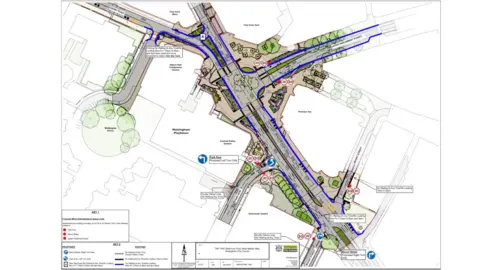 Nottingham City Council
Nottingham City CouncilAside from replacing the roundabout with a T-junction, the work also involves:
- Altering the junction between Mount Street and Maid Marian Way to make it "simpler for pedestrians to cross the road"
- A new left turn will be opened on Park Row to allow traffic to head north on to Maid Marian Way for routes heading north and east
- "Improved" cycle facilities around the area of the new T-junction
- The replanting of 41 large native trees
How much disruption has been caused?
Days after the new junction opened, bus operator trentbarton and Nottingham City Transport (NCT) warned of delays to services due to the changes, with the latter saying bus users had been "disproportionately affected".
NCT was established as an arms-length city council company in 1986 but is independent of council issues. It was particularly critical of the situation, saying it had raised "strong concerns" over the changes.
Tom Bridge, operations director at trentbarton, said some of its buses had experienced delays of up to 55 minutes.
Another bus driver previously told the BBC that journey times had been considerably longer.
"You really are sat there for quite a while, and then the passengers are on your mind, and you know they have places to be and they're the ones properly affected by this – you can see it," he said.
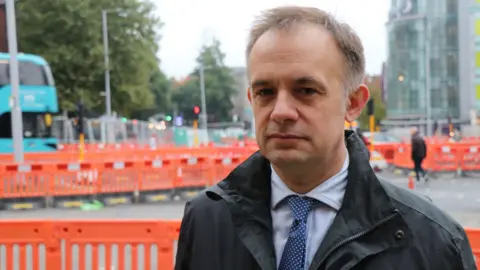
What have people had to say about it?
Shortly after the council announced the new T-junction was operational, hundreds of people took to social media to complain about the plans.
Writing on the BBC Nottingham Facebook page, one questioned why a "perfectly functional" roundabout had been ripped out, while another said the council was "fixing something that wasn't broken".
In response, Khan told the BBC the new layout would not cause more congestion than the original roundabout.
"At the end of the project, they [drivers and bus passengers] won't be any worse off. We are monitoring that as we're going along," she said.
Some nearby businesses have also expressed their unhappiness.
Milee Kim, owner of Ubeauty Clinic on Upper Parliament Street, said many of its customers had cancelled appointments because of the congestion.
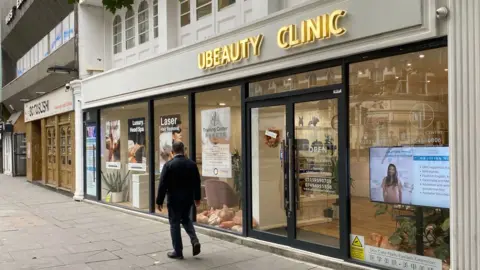
"It's really, really bad for our business," she said. "Normally we have 20 clients [a day]. Now it's only three or four."
She added: "They [clients] are calling us saying, 'I need to cancel the appointment because of traffic'.
"The buses [which stop near the salon] are sometimes cancelled, so the client can't catch the right bus from their location to here. This is the big problem."
Another business owner, who asked to remain anonymous, said their walk-in trade had dropped by 50% since the works had started, blaming a decline in footfall on "off-putting" barriers along the pavement and the relocation of a pedestrian crossing.
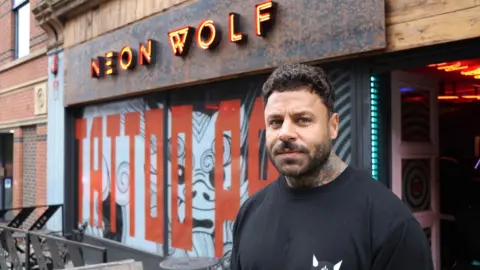
But James Irons, owner of Neon Wolf tattoo studio on Derby Road, said he was largely in favour of the plans and thinks it could improve trade.
"If it opens up and becomes less of a roundabout [and] more of a pedestrianised area, then it's good for us because it draws us a little bit closer to the city centre," he said.
What's changed since the T-junction came in?
The council has already made changes to the junction, following criticism from bus firms and residents.
This week NCT said, after discussions with the local authority, alterations to the construction and signal phasing had been made to allow buses to flow through.
A council spokesperson said a short section of bus lane had been added in the approach to the bus stop on Tollhouse Hill to help buses get through.
They said a yellow box had been added "so that motorists don't block the junction" and signal phasing had been adjusted.
A council spokesperson previously emphasised that the situation was "temporary while works are in progress".
Council leader Khan apologised for the disruption, but said businesses would feel the benefits of an increase in footfall once the project was complete.
"I've got no problems apologising to the people who were delayed in those early stages," she said.
"I just feel like if you want to be ambitious for the city, like we are, and if we're doing big construction [projects] that take over a year to do, there will be disruption.
"When this project is complete next summer, they [businesses] will see all the benefits and this will be a busy, busy part of the city centre that currently doesn't have enough of the footfall that it will see when the project is complete."
Follow BBC Nottingham on Facebook, on X, or on Instagram. Send your story ideas to [email protected] or via WhatsApp on 0808 100 2210.
